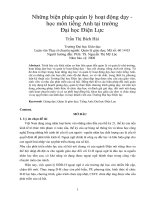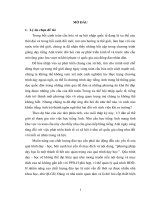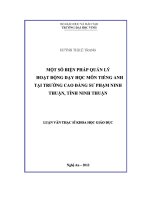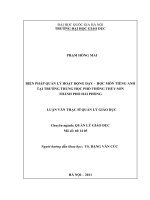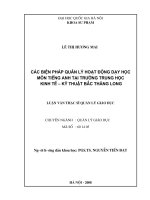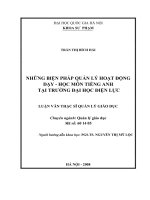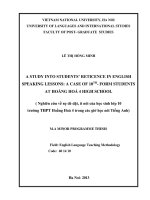Nghiên cứu về sự băn khoăn lo lắng của học sinh lớp 12 trước khi làm bài thi môn tiếng anh tại kỳ thi tốt nghiệp phổ thông trung học quốc gia tại trường thpt huỳnh thúc kháng
Bạn đang xem bản rút gọn của tài liệu. Xem và tải ngay bản đầy đủ của tài liệu tại đây (980.17 KB, 77 trang )
VIETNAM NATIONAL UNIVERSITY, HANOI
UNIVERSITY OF LANGUAGES AND INTERNATIONAL STUDIES
FACULTY OF POST- GRADUATE STUDIES
NGUYỄN THỊ HỢP
A STUDY OF THE ANXIETY OF THE 12TH GRADERS BEFORE THE
ENGLISH TEST IN THE NATIONAL UPPER SECONDARY
GRADUATION EXAMINATION AT HUYNH THUC KHANG
HIGH SCHOOL
(Nghiên cứu về sự băn khoăn, lo lắng của học sinh lớp 12 trước khi làm
bài thi môn Tiếng Anh tại kỳ thi tốt nghiệp Phổ thông trung học
Quốc Gia tại trường THPT Huỳnh Thúc Kháng)
M.A. MINOR PROGRAMME THESIS
Field: English Teaching Methodology
Code: 60140111
HANOI - 2017
VIETNAM NATIONAL UNIVERSITY, HANOI
UNIVERSITY OF LANGUAGES AND INTERNATIONAL STUDIES
FACULTY OF POST- GRADUATE STUDIES
NGUYỄN THỊ HỢP
A STUDY OF THE ANXIETY OF THE 12TH GRADERS BEFORE THE
ENGLISH TEST IN THE NATIONAL UPPER SECONDARY
GRADUATION EXAMINATION AT HUYNH THUC KHANG
HIGH SCHOOL
(Nghiên cứu về sự băn khoăn, lo lắng của học sinh lớp 12 trước khi làm
bài thi môn Tiếng Anh tại kỳ thi tốt nghiệp Phổ thông trung học Quốc
Gia tại trường THPT Huỳnh Thúc Kháng)
M.A. MINOR PROGRAMME THESIS
Field: English Teaching Methodology
Code: 60140111
Supervisor: Assoc. Prof. Dr. Trần Xuân Điệp
HANOI - 2017
DECLARATION
I certify that I myself write this thesis entitled “A study of the anxiety of the
12 th graders before the English Test in the National Upper - Secondary Graduation
Examination at a School in Hanoi.” It is not a plagiarism or thesis written by
others. I assure that I wrote anything related to others‟ works in quotation. If then
the pronouncement proves wrong, I am ready to accept any academic punishment,
including the withdrawal or cancellation of my academic degree.
Hanoi, May 2017
Nguyễn Thi ̣Hơ ̣p
i
ACKNOWLEDGEMENT
I would like to express my sincere appreciation to many people supporting
me to complete this current study.
Firstly, I would like to show my deepest gratitude to my respectful
supervisor, Assoc. Prof., PhD. Tran Xuan Diep, who gave me a lot of professional
advice on the thesis writing. I am grateful to his kind consideration, tender
guidance, critical feedback, and insightful suggestions. Without his care, I could
not have been able to finish this study.
Secondly, I would also like to acknowledge my gratefulness to the
participants of this study the 12 grader students at Huynh Thuc Khang high school.
This study could not have been conducted but for their willingness to complete the
questionnaires and participate in the interviews.
Finally, I wish to express my deep thanks to my dear family, especially my
husband for their love, encouragement, immeasurable support, and concrete help
for me to complete this research.
ii
ABSTRACT
Test anxiety plays a significant role in one‟s educational, professional, and
emotional life. Therefore, it is not surprising that the testing environment causes
anxiety to a number of individuals. This study carried out aimed at investigating
main causes of anxiety and some possible solutions. Data collected from the
participants (class 12A and 12B at Huynh Thuc Khang high school with 84
students) by employing quantitative (questionnaires) and qualitative (interviews)
methods as research instruments including study skills, perceived threat of tests,
and performance attributions. The results are interpreted to propose that some
causes believed to contribute to students‟ anxiety were also identified, among
which the difficult content, the poor preparation and the difficulties in selecting the
related materials seemed to be most highly considered by the students. Moreover,
The results revealed that giving a clear introduction for the difficult types of the
exercises, providing well-designed samples of tests and doing exercises from
different sources were offered to help students acknowledge, cope with and reduce
anxiety as well as select an appropriate method of learning to take the actual
English Examination with the lower anxiety.
iii
TABLE OF CONTENTS
DECLARATION ....................................................................................................... i
ACKNOWLEDGEMENT ....................................................................................... ii
ABSTRACT ............................................................................................................. iii
TABLE OF CONTENTS ........................................................................................ iv
LISTS OF ABBREVIATIONS ............................................................................. vii
LIST OF TABLES AND FIGURES .................................................................... viii
PART A: INTRODUCTION ....................................................................................1
1.1. Rationale for the research .................................................................................1
1.2. Aims and Objectives of the study .....................................................................2
1.3. Research questions ............................................................................................2
1.4. Scope of the study .............................................................................................2
1.5. Methods of the study ........................................................................................2
1.6. Organization of the study..................................................................................3
PART B: DEVELOPMENT.....................................................................................4
CHAPTER 1. LITERATURE REVIEW ................................................................4
1.1. Theoretical background ....................................................................................4
1.1.1. Definitions: Anxiety and Test anxiety .......................................................4
1.2.2. Kinds of anxiety .........................................................................................4
1.1.3. Causes of test anxiety .................................................................................5
1.1.4. Solutions to anxiety ....................................................................................7
1.2. Review of previous related studies ...................................................................8
1.3. Summary ...........................................................................................................9
CHAPTER 2. METHODOLOGY .........................................................................10
iv
2.1. The context of the study .................................................................................10
2.1.1. Research settings ......................................................................................10
2.1.2. Research participants ................................................................................10
2.2. Research methodology....................................................................................10
2.2.1. Definition of Survey Research .................................................................10
2.2.2. Advantages of Survey Research ...............................................................11
2.2.3. Main steps in conducting Survey Research..............................................12
2.2.4. Data collection instruments ......................................................................12
2.2.5. Data collection procedures .......................................................................15
2.2.6. Data analysis .............................................................................................15
2.3. Summary .........................................................................................................16
CHAPTER 3. FINDINGS AND DISCUSSIONS .................................................17
3.1. Descriptive statistics .......................................................................................17
3.1.1. Descriptive statistics of causes related to knowledge content and personal
barrier .................................................................................................................17
3.1.2. Descriptive statistics of some factors concerning studying habits and
gathering related materials .................................................................................17
3.1.3. Descriptive statistics of causes related to poor preparation and
performance beyond control ...............................................................................18
3.1.4. Descriptive statistics of solutions to anxiety ............................................18
3.2. Quantitative description of results from the questionnaire and qualitative
description of results from semi-interview ............................................................19
3.2.1. Causes related to knowledge content and personal barrier ......................19
3.2.2. Causes related to studying habits and gathering related materials ...........24
3.2.3. Causes related to poor preparation and performance beyond control ......29
v
3.2.4. Solutions to anxiety ..................................................................................32
3.3. Summary .........................................................................................................40
PART C: CONCLUSIONS ....................................................................................41
1. Recapitulation ....................................................................................................41
2. Implication from the study.................................................................................42
3. Limitations and suggestions for further study ...................................................43
REFERENCES ........................................................................................................44
APPENDICE 1 .......................................................................................................... I
APPENDIX 2 .......................................................................................................... VI
APPENDIX 3 .......................................................................................................... IX
APPENDIX 4 .......................................................................................................... XI
vi
LISTS OF ABBREVIATIONS
TAS : Test Anxiety Scale
SPSS : Statistical Package for Social Sciences
vii
LIST OF TABLES AND FIGURES
Page
Table 1:
Reliability Statistics .................................................................................17
Table 2:
Reliability Statistics .................................................................................17
Table 3:
Reliability Statistics .................................................................................18
Table 4:
Reliability Statistics .................................................................................18
Table 5:
KMO and Bartlett's Test ..........................................................................19
Table 6:
Causes related to knowledge content and personal barrier ....................20
Table 7:
Causes related to studying habits and gathering related materials ..........24
Table 8:
Causes related to poor preparation and performance beyond control .............29
Table 9:
Solutions to anxiety .................................................................................33
viii
PART A: INTRODUCTION
1.1. Rationale for the research
Nowadays, the significance of tests and academic achievements tends to be
drawn much more attention by society. Hence, it puts pressure on students to
“succeed,” which leads students to have high anxiety and stress and then affects the
individuals‟ results. It is urgent that anxiety and the immediate need for treatment
draw more and more attention of educators, not only for today but also for the
future. Anxiety is becoming one of the most common and wide-spreading mental
illnesses. The need for treatment should be drawn more attention and the school has
become a wonderful place to treat anxiety (Masia -Warner et al., 2005).
In Vietnam, nowadays test is becoming a growing issue to the society
especially to the students and parents respectively, simply because there have been
so many changes in the examination regulation in recent years in a short time.
At Huynh Thuc Khang high school, where I have been teaching English for a
long time, in some classes, students expressed negative attitude towards the change
in English Test format in the National Upper-Secondary Graduation Examination.
From my personal observation and professional experience, I realized that students
were unable to work out all of the answers to the questions in the samples of tests
they had to do in class and at home. Therefore, they seemed to be tired when doing
the samples of the English Tests. In addition, students were confused about
selecting the best ways to prepare for the actual examination. Moreover, I was
aware that students spent a great deal of time discovering exercises from a variety
of sources but they seemed to fail, because they did not have enough abilities to find
out what materials were suitable for their revisions. As an English teacher, the
researcher feels anxious about finding the proper teaching method to help the
students to have a better orientation of examination. Such a situation has inspired
the author to carry out “A study of the anxiety of the 12th graders before the English
1
Test in the National Upper-Secondary Graduation Examination at Huynh Thuc
Khang high school.”
1.2. Aims and Objectives of the study
The aim of the study is to do research on causes of anxiety and some possible
solutions to the 12th graders before the English Test in the National UpperSecondary Graduation Examination. The objectives of the study were:
1. To find out the main causes of anxiety among the 12th graders before the English
Test in the National Upper-Secondary Graduation Examination.
2. To suggest some solutions to anxiety
1.3. Research questions
In dealing with the aims above, the thesis should focus on finding out the
answers to the following questions:
1. What are the main causes of anxiety among the 12th graders before the English
Test in the National Upper-Secondary Graduation Examination?
2. What are some possible solutions to anxiety?
1.4. Scope of the study
The researcher focused on the subjects‟ anxiety of the English Test in the
National Upper-Secondary Graduation Examination with its causes of anxiety and
solutions before the examination. Moreover, due to the pressure of the time, this
study carried out at the mid-term of school year 2016-2017 only involves a small
number of the 12th graders (two classes with 84 students) at Huynh Thuc Khang
high school.
1.5. Methods of the study
The data serving the research analysis collected by employing both
quantitative (questionnaires) and qualitative methods (interviews) provided the
study with information and evidence.
2
1.6. Organization of the study
The thesis consists of three main parts.
Part A is the INTRODUCTION, which consists of rationale, aims, and objectives of
the study and research questions. It also covers scope, methods, and organization of
the study.
Part B is the DEVELOPMENT separated into three chapters:
+ The first chapter provides the basic theoretical background related to anxiety, test
anxiety, and kinds of anxiety. Especially, this chapter mentioned possible causes of
anxiety and solutions, which are the main issues of the study and the previous
studies in brief.
+ The second chapter is concerned with methodology used in the study. In the first
place, author restates the research questions and emphasizes the context, settings,
participants, instruments, data collection, and analysis procedure in the process of
conducting the study.
+ The third chapter shows the main content with findings as well as discussions
based on the results from questionnaires and interviews.
Part C is the CONCLUSION offering a summary of the mentioned issues, the
implication for the study and the limitations and suggestions for further study.
3
PART B: DEVELOPMENT
CHAPTER 1
LITERATURE REVIEW
This chapter aims to shed light on the theory and research findings related to
anxiety and test anxiety and the previous related studies of this issue that the
researcher utilized to construct the conceptual framework for the present study. The
theoretical background covers the following topics: definition of anxiety and test
anxiety, types of anxiety, main causes of anxiety and its solutions.
1.1. Theoretical background
1.1.1. Definitions: Anxiety and Test anxiety
1.1.1.1. Definitions of anxiety
At the beginning of the twentieth century, Freud (1920) thought anxiety was
akin to “fear” or fright.” Scovel (1978: 134) suggests that anxiety relates to feelings
of uneasiness, frustration, self-doubt, apprehension, or worry. Horwitz, et al. (1986),
define anxiety as “the subjective feeling of tension, apprehension, nervousness, and
worry associated with an arousal of the autonomic nervous system”
1.1.1.2. Definitions of test anxiety
Test anxiety is a strong emotional response in which an individual
experiences before and during an examination (Akca, 2011). Usually, situations in
which personal evaluations is allowed by individuals are defined as situational
evaluation, will possibly cause high levels of performance.
1.2.2. Kinds of anxiety
1.2.2.1. Trait Anxiety
Brown (1994) shared opinions that Trait anxiety occurred when there was a
likelihood of an individual becoming anxious in any situation.
4
Jonassen and Grabowski (1993) reported that the trait anxiety perspective
was productive in reporting effects of generalized anxiety and it has been applicable
across situations.
1.2.2.2. State Anxiety
Spielberger (1983),Chen and WU (2004) regarded state anxiety as
unsatisfactory temporary emotional state or condition, activated by the individuals‟
nervous system such as the experiences in apprehension before taking a test.
Jonassen and Grabowski (1993) revealed that it depends on an event or
combination of events experienced at the time. It shows a transient emotional mood
or condition. According to them, state anxiety determined by the interaction of trait
anxiety may cause individual to perceive situational threat perceive, and so is
responsive to situational factors. An individual who generally responds to any
number of situations with low anxiety may react to high anxiety if there are multiple
anxiety-causing conditions present.
1.1.3. Causes of test anxiety
MacDonald (2010) found out that there were a variety of factors affecting
test anxiety among which there were bad attitude of teachers to the applications in
doing test, responses of the students towards learning, the inabilities of the test
among students, being under fear of negative evaluation, having experience in
examination terribly, being under pressure of time. Besides, the fact that content
was complicated and parental expectations to children‟s taking exams were clearly
shown as some of factors leading to anxiety.
Hills & Benlow, (2008) indicated that there was a correlation between learning
method and anxiety, because it can make a person study and pass examinations much
more easily. Insufficient and inefficient studying can contribute to increasing the test
anxiety experienced by a student (Cassady, 2010). Peleg, (2009) stated that students‟
poor performance on test may firstly due to insufficient studying and preparations;
learning was under the dependence on others. Besides, family expectations or badly
5
designed tests may make students experience pressure, loss of concentration and
inattention, difficulties in memory during the following tests
In other words, Hills & Benlow, (2008) and Cassady, (2010) Peleg, (2009)
showed that a suitable studying skill is considered as a better quality of test
performance. It means that the more students prepare knowledge with an
appropriate method, the better their test results are. By contrast, from the point of
MacDonald‟s view, a set of causes of test anxiety were found out like bad attitude of
teachers to the applications in doing test, students‟ attitude towards learning, fear of
negative evaluation, bad examination experiences, time limitation, difficult course
content and parental expectations when conducting his research.
Gettinger and Seibert (2002) believed that there was a close relationship
between academic competence, the knowledge, and application of effective study
skills. According to them, students having good study skills are more likely to
achieve academic competence. They make out task demands, and are able to
perform flexible, effective strategies to succeed academically. Thus, both of the
researchers hold the idea of effective study skills introduced to improve academic
performance, strategic knowledge, and affective responses among students with
learning problems across multiple academic domains (Harvey & Goudvis, 2000).
According to them, studying habit is one of the causes of test anxiety. In
other words, if students know how to apply their knowledge to the test together with
an effective studying habit, the better results they can obtain. In addition to the
studying habit, some other researchers identified another cause such as locus of
control described as the cause of success or failure (Barzegar, 2011). In the same
vein, Bostic (2010) found out that there is a significant difference in academic
achievement of students. According to him, students that have internal locus of
control are more successful than those who have external locus of control.
In general, the researcher‟s concern is to find out some causes of anxiety
among the 12th graders before the English Test in the National Upper - Secondary
6
Examination at a school in Hanoi, and whether these findings tend to be consistent
with MacDonald (2010).
1.1.4. Solutions to anxiety
Gonzalez (1995) stated that improving their testing skills would decrease
their anxiety and make their scores better. When preparing for standardized tests, it
was recommend by Carter et al. (2005) and Conner (2003) that if we increase skills
in doing actual test, we should practice the same samples as the actual test. Besides,
Carter et al. (2005) added that providing students with an explanation for each
strategy, a set of opportunities to watch someone model the strategy, repeated
opportunities for students to practice and applying the strategies by using practice
tests could be considered the ways to reduce test anxiety.
Woodard (2004) indicated that teachers could also apply techniques to
prevent and reduce anxiety in class. Providing students with clear explanations and
suggested knowledge for revision was the solutions to anxiety. To be more specific,
it is useful to teach the students to acquire critical thinking and enthusiasm about the
subject. Moreover, giving feedback and partial credit, reviewing for exams, and
offering alternative testing times may be the ways to decrease anxiety. Oxford &
Vordick (2006) reported that although solutions to anxiety were incomplete, it
might assist teachers in incorporating greater structures into the lesson plans, and
encourage an interactive classroom that will stimulate questions.
Generally, appropriate learning strategies can also help student recall, store,
and apply the knowledge while they are studying. However, which strategies and
how are applied effectively is referred in the study with a view to reducing the
students‟ test anxiety before the test. In particular, the solutions to anxiety in the
studies of (Woodard, 2004) and (Oxford & Vordick, 2006) considered to conduct
this study with the author‟s participants to find out the suitable ways to reduce test
anxiety before the English Test in the National Upper-Secondary Graduation
Examination.
7
1.2. Review of previous related studies
In fact, the studies of anxiety and test anxiety have drawn much attention of
researchers in Vietnam as well as other countries.
Antwi-Danso, Amissah and Effrim (2015) carried out a survey of the
relationship between test anxiety and academic achievements of third-year senior
high school students in the Agona Municipality of Ghana with 270 participants. The
results revealed that students should be orientated towards study skills acquisition as
well as anxiety reduction strategies for better results.
Olaitan and Moroluyo (2014) aimed at investigating how the test anxiety,
studying habits, and locus of control affected the academic performance among
college students with 508 participants by employing questionnaire. The study
ascertained that there was a close relationship between academic performance, noncognitive and socio-psychological changes. Therefore, early intervention and
immediate prevention programs were developed and applied, which would aid to
reduce students‟ anxiety. Particularly, good study strategies such as evaluating the
understanding level, making sense of the information from the textbook and
realizing the aim of learning a particular thing were developed.
Augustina Dubem Nwajei (2013) conducted the study of “Test anxiety,
depression and academic performance: Assessment and arrangement using
relaxation and cognitive restructuring techniques” with a view to investigating the
changes in degrees of anxiety among 420 participants at senior secondary. The
results show that test anxiety, trait anxiety, and depression existed together and have
a positive relationship, and they had negative effect on academic performance.
Besides, it is better to combine the relaxation with the cognitive restructuring
treatment to reduce anxiety and depression instead of relaxation treatment alone.
The findings thus present the effectiveness of cognitive therapy in controlling
anxiety and depression and improving academic performance.
8
In the context of Vietnam, Hoang Thi Mai Hoa (2011) was concerned about
factors affecting the students‟ English oral presentation skills by using
questionnaire instrument to carry out the study at Hanoi Tourism College with the
106 participants. She drew conclusion from the findings that the expressions of the
ideas with words was pronounced exactly, the fluency in presentation and creating a
good manner were three of the factors having influence on the skills of oral
presentation in English. Besides, she believed that poorly - prepared plan was also
one of the factors of the students‟ English oral presentation skills.
Ho Thi Anh (2013) did a survey of students‟ anxiety conducted in five firstyear classes with the participants of 50 students in speaking class at Academy of
policy and development. The main instruments of the study were interview and
questionnaire. These findings showed that personal and interpersonal problems
were causes of anxiety in speaking among students.
From the previous studies related to the research problems, the writer
conducted the study on the 12th grader students at a school in Hanoi as the target
population.
1.3. Summary
This chapter has established the theoretical background concerned with the
topic of the research. It has mentioned definition of anxiety and test anxiety, causes
of test anxiety and its solutions and previous related studies. The next chapter will
show the findings and results from questionnaires and interviews in detail.
9
CHAPTER 2
METHODOLOGY
2.1. The context of the study
2.1.1. Research settings
The study was conducted at Huynh Thuc Khang high school when all
students at the school prepared knowledge for the National Upper-Secondary
Graduation Examination for the university entrance or other purposes. The students
at school have English three lessons (periods) which mainly based on the textbook a
week and the contents of the lessons of textbook are chiefly taught in the morning.
In addition, the 12th graders did several of samples of the English Test to revise
knowledge for the compulsory examination 8 periods per week (45 minutes each).
The number of the 12th students at Huynh Thuc Khang high school is estimated at
200 students with differences in levels of English. Particularly, the students are
facing many difficulties in preparing for an examination.
2.1.2. Research participants
The participants in this study were 84 students of the class 12A and 12B in
the academic year 2016-2017. After the Ministry of education and training had
provided the 12th students with the sample of tests, the teacher-researcher wondered
how the learners should do to master skills and knowledge for an actual
examination. Hence, the researcher selected them as the participants in the Survey
Research to find out causes of anxiety and solutions for helping the students to do
the actual examination with the flying colour.
2.2. Research methodology
2.2.1. Definition of Survey Research
Survey Research Design (SRD) defined
10
“A survey research is a study of a large group (a population) through direct study of
a subset of that group (a sample)”.
(Johnson D.M, 1992:104)
A survey design uses various data collection procedures to enable the
teacher-researcher-educator-educator (TREE) to investigate a construct by asking
questions of either fact (descriptive) or opinion (explanatory) from a sample of a
population with a view to generalizing to the population. The term survey is an
umbrella term that allows for many data collection procedures including
questionnaires, interviews, and observations.
2.2.2. Advantages of Survey Research
Survey design can generate not only descriptive summary but also
generalized statements based on large databases (Cohen, Manion, & Morrison,
2000, p. 171).
Survey design is good for providing information for curriculum
development, including needs analysis and program evaluation, as well as
researching certain topics (Brown, 1997).
It is also good at collecting data on groups too large to observe directly
(Babbie, 2004). Furthermore, the data collection instruments (questionnaires) used
to gather data in a relatively short time to get the results analyzed statistically.
Based on the definition mentioned, Survey Research is appropriate for this
study. Firstly, this aim of the research was to find out the causes of anxiety by
asking the students designed questions concerning opinions or attitude of the
learners towards the problem done by the researcher. Secondly, the researcher did a
survey with a small sample of the class 12A and 12 B mainly before the actual
examination. Therefore, with the good points of the Survey Research provided by
(Cohen, Manion, & Morrison, 2000, p. 171), (Brown, 1997), and Babbie, 2004), the
researcher selected the survey research to gain the expected results.
11
2.2.3. Main steps in conducting Survey Research
1. Planning survey project
2. Designing survey instrument
3. Gathering & compiling survey data
4. Analyzing survey data statistically
5. Analyzing survey data qualitatively
6. Reporting survey results
(Brown J.D, 2005, p.8)
2.2.4. Data collection instruments
2.2.4.1. Survey Questionnaires
Part
Kinds
Items
Part 1
Perceived Threat of tests
6
Part 2
Study skills
6
Part 3
Test performance attributions
5
2.2.4.1.1. Perceived Threat of Tests
Lay, Edwards, Parker, Endler (1989), Schwarzer and Jerusalem (1992)
presented that students who suffered from high-test anxiety tended to perceive tests
as threatening events because they saw the next evaluative situations as a stressful
event.
Bandalos, Yates, Thorndike-Christ (1995) Schutz, and Davis (2000)
provided Students‟ explanations for this perceived threat are that they have a
generalized low-self efficacy for testing or the specific subject matter is complex
and difficult.
12
Students‟ perceptions of testing events were evaluated prior to taking the test
with the 6 items. Perceived Threat of Tests developed for the purposes of this study
(See Appendix 1) focuses on the awareness of the next test as threatening, either
due to general difficulty of course content or personal barriers to success on the test.
Participants respond to a five -point Likert type scale, with responses ranging from
“strongly disagree” to “strongly agree.”
2.2.4.1.2. Study skills
Everson, Smodlaka, and Tobias (1995) revealed that students experienced
high-test anxiety when they had deficits in encoding and storage processes
associated with reading materials during preparation for tests.
Culler & Holohan (1980) and Wittmaier (1972) claimed that the inability to
employ effective study skills prevented students with test anxiety from cognitive
processes. Furthermore, they showed that students with high-test anxiety studied
much more than their low anxiety peers but the study methods were highly
repetitive and less effective.
Study skills include a set of six items regarding the habits and skills students
used to prepare for exams or gather the materials related to the exams. Participants
respond to a five-point Likert - type scale, with responses ranging from “strongly
disagrees” to “strongly agree.” (See Appendix 1)
2.2.4.1.3. Test performance attributions
Schwarzer and Jerusalem (1992) represented that as students experienced
situations involving internally based attributions for failure, it assured that the
upcoming tests were likely to be threatening. In other words, students would move
beyond the motivational „„Challenge Stage‟‟ and progress into a stage where threat
is dominant. In cases where the students develop attributions that have the locus of
control externalized, the development of a „„Loss of Control‟‟ perspective is
prompted.
13
Students‟ perceptions and beliefs about performance were gathered with 5
items. Participants responded to these items using the five-point Likert - type scale,
ranging from „„strongly disagree‟‟ to „„strongly agree”. Test performance
attributions focuses on the poor preparation and performance beyond the control.
( See Appendix 1).
In general, to avoid being constrained by the use of a second language, the
researcher translated all of the questions in the survey into Vietnamese, because the
levels of English are not good enough to understand all the contents of the
questions.
2.2.4.2. Interviews
Part
Kinds
Items
Part 1
Interview for teachers
5
Part 2
Interview for students
5
The interview for students consists of five items conducted in Vietnamese,
which were open enough to allow the interviewees to be free to express themselves
and assists the participants to express fully their views of being constrained by the
use of a second language. Then all their answers to the questions were translated
into English to use in this study.
There are three parts in the interview. In the first part, question 1 related to
attitude towards anxiety was raised. The purpose of this part was to find out whether
students had experienced the feelings of anxiety or not. The second part with
question 2 focused on the main causes of anxiety among the 12th graders before the
English Test in the National Upper-Secondary Graduation Examination. The third
part with question 3, 4, and 5 aimed to finding solutions to this problem. The data
from the interviews analyzed aimed at providing the researcher with a deep
14
understanding of the problems, on which the researchers based to find possible
solutions to anxiety.
The interview for teachers is composed of five items. The interview carried
out in Vietnamese for the teachers to express more and more opinions in a short of
time. Afterwards, all their answers to the questions were translated into English
with a view to using in the study.
The interview consists of three parts. The first part (Question1) designed
concentrated on finding out whether students were nervous or not. The second part
with question 2, 3, and 4 was to explore causes of anxiety. The last one (Question 5)
was to find out the possible solutions to anxiety.
2.2.5. Data collection procedures
The study included four steps. First, the author translated the statements in
the scale into Vietnamese in order to overcome the incapability of self-expression in
English. Secondly, the author sent it to the supervisor to correct the mistakes in
translations. Thirdly, the researcher delivered questionnaires measuring the causes
of anxiety and solutions to participants as soon as they entered the exam hall. It took
the participants a maximum of 30 minutes to answer the questionnaire containing
two major parts: asking questions to find out causes of anxiety and solutions (See
Appendix 1).And then interviews (10 random students) (See Appendix 2) were
carried out two days later. Finally, the researcher conducted the interviews 7 of
random teachers (See Appendix 3) 5 days later.
2.2.6. Data analysis
While the data from the questionnaires were analyzed quantitatively, the data
from the interview were analyzed qualitatively.
The data collected were calculated and analyzed by using the software
named Statistical Package for Social Sciences (SPSS), version 20.
15

